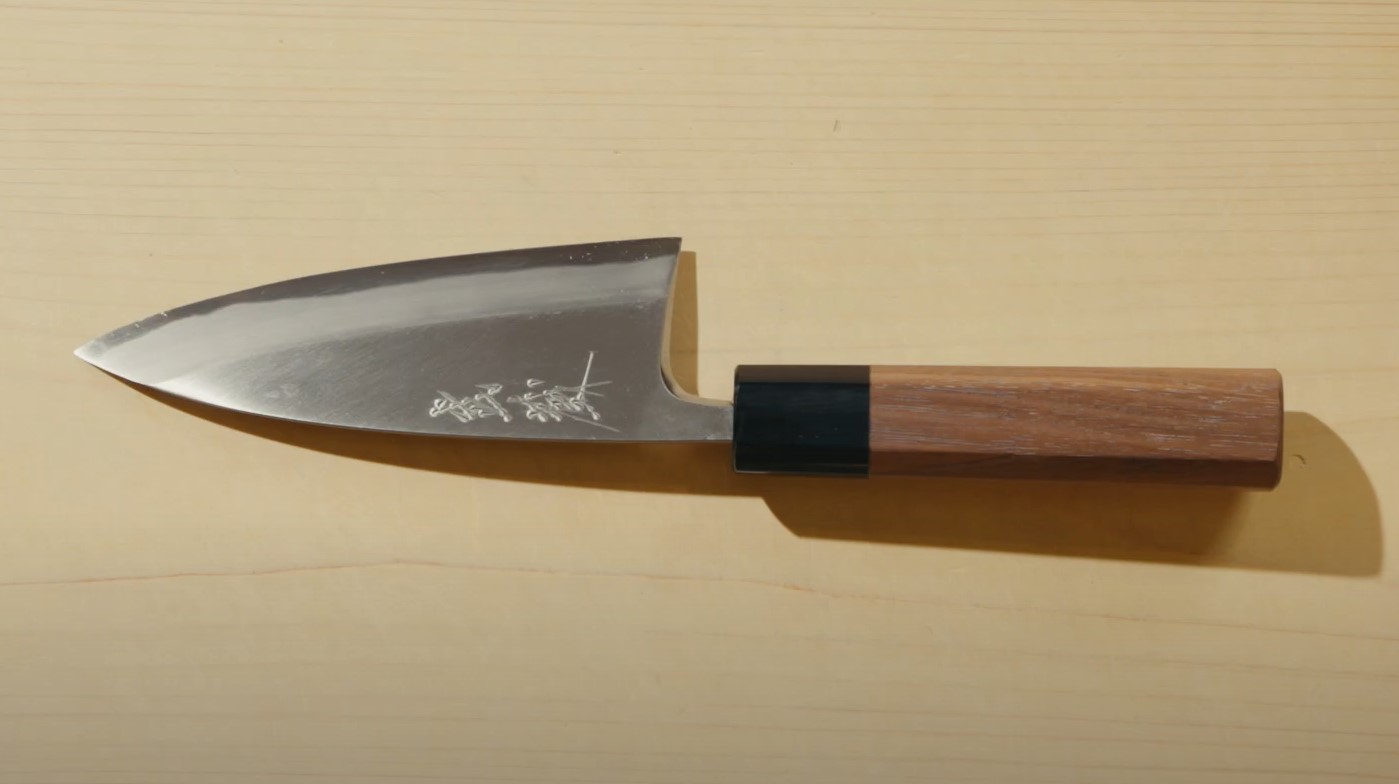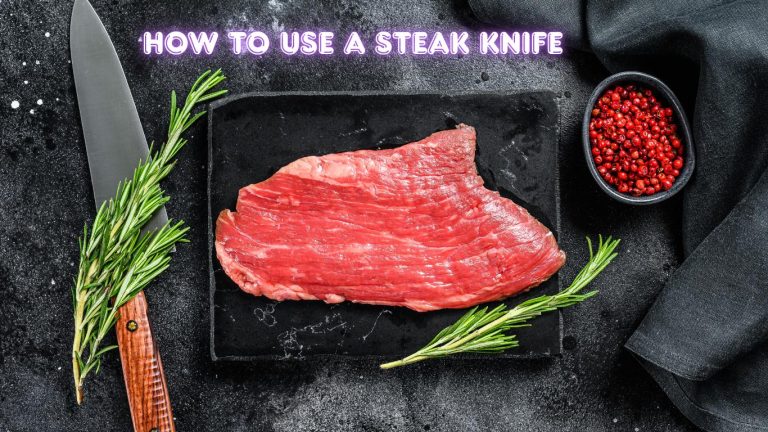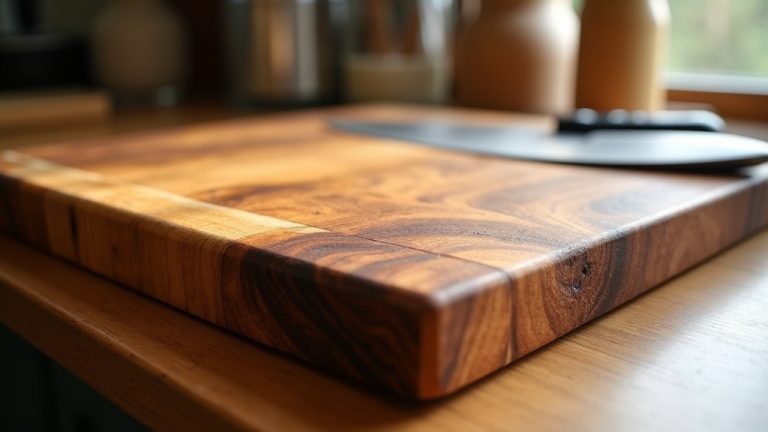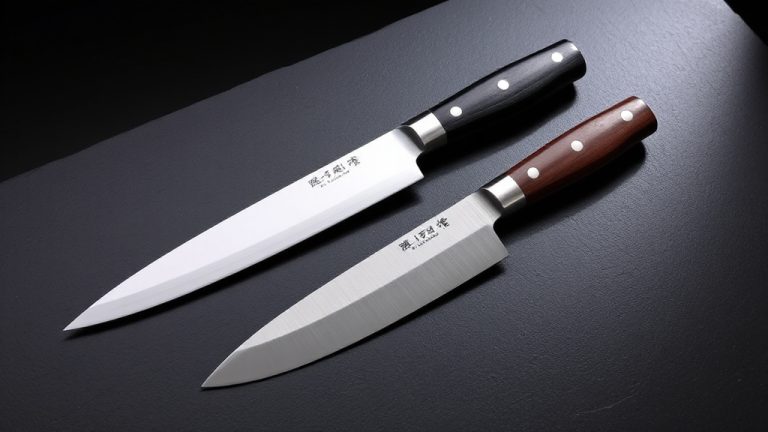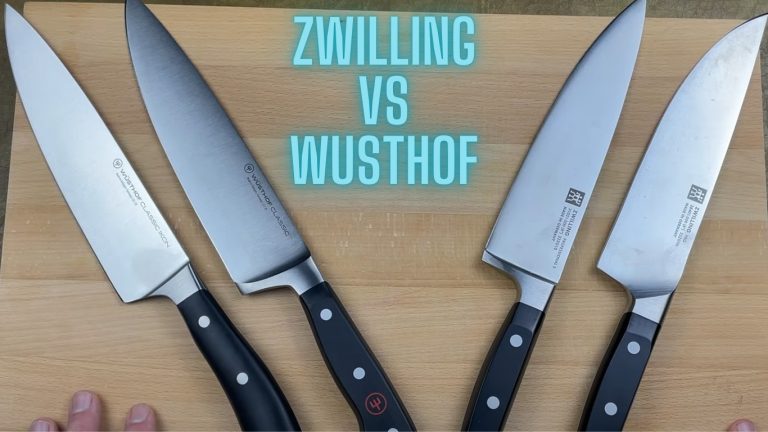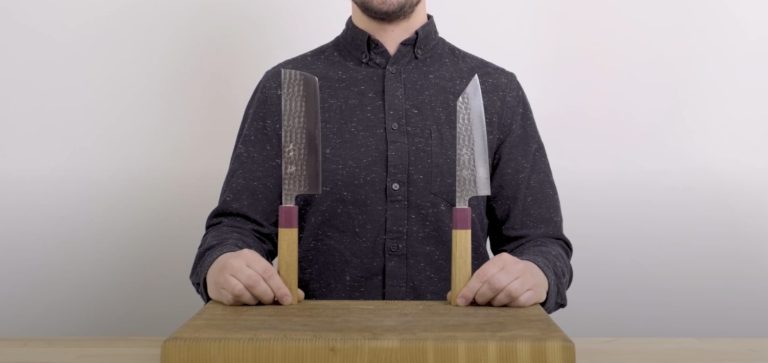Best Deba Knives: You’ll Want in Your Kitchen
Looking for the best Deba knives to elevate your kitchen skills? You’ll love options like the KEEMAKE 6-inch for its budget-friendly precision, or the kai Seki Magoroku Kinju ST 150mm for its sturdy grip.
Don’t overlook the Kai Wasabi 6-inch for filleting ease, or the Sakai Takayuki 165mm for exceptional sharpness.
Each knife offers unique strengths for fish and poultry tasks. Stick around to uncover more insights on choosing your perfect blade.
| Image | Name | Editor's Rating | Price |
|---|---|---|---|

|
KEEMAKE Deba Knife 6 inch, Double Bevel ...
|
|
|

|
Kai Seki Magoroku Kinju ST Japanese Deba...
|
|
|

|
JapanBargain, Deba Knife Made in Japan, ...
|
|
|

|
Kai Wasabi Deba Knife 6", Traditional Ja...
|
|
|

|
青木刃物製作所 Sakai Takayuki Jap...
|
|
Key Takeaways
- KEEMAKE Deba Knife 6 inch offers affordability with Japanese 440C stainless steel and a comfortable rosewood handle.
- kai Seki Magoroku Kinju ST 150mm (AK-1101) features durable molybdenum vanadium steel, weighing 8.54 ounces for balanced use.
- JapanBargain Japanese Deba Knife 6-1/4 inch is lightweight and rust-resistant, ideal for slicing fish and meats.
- Kai Wasabi Deba Knife 6 inch is budget-friendly, made of high-carbon stainless steel for filleting tasks.
- kai Seki Magoroku Kinju ST 180mm (AK-1103) weighs 10.51 ounces, perfect for precision butchering with an octagonal handle.
KEEMAKE Deba Knife 6 inch, Japanese Stainless Steel Fish/Fillet Knife

If you’re a home chef or sushi enthusiast looking for a reliable and affordable tool, the KEEMAKE Deba Knife 6 inch is a standout choice.
Crafted from Japanese 440C stainless steel, it boasts sharpness and rust resistance with a non-stick black coating for easy cleaning.
You’ll appreciate the balanced design and comfortable rosewood handle with a G10 bolster, perfect for slicing fish, meat, or veggies. While it holds an edge well, you might need to sharpen it every few weeks.
Best For: Home chefs and sushi enthusiasts seeking an affordable, sharp, and reliable knife for everyday kitchen tasks.
Pros:
- Exceptional sharpness out of the box with Japanese 440C stainless steel for precise cuts.
- Rust-resistant and non-stick black coating for easy maintenance and cleaning.
- Comfortable rosewood handle with G10 bolster, offering balance and a secure grip.
Cons:
- Edge retention is not as strong as higher-end professional knives, requiring frequent sharpening.
kai Seki Magoroku Kinju ST Japanese Deba Knife 150mm (AK-1101)

Discover the kai Seki Magoroku Kinju ST Japanese Deba Knife 150mm (AK-1101), a top pick for seafood enthusiasts and professional chefs who demand precision in fish preparation.
You’ll appreciate its molybdenum vanadium stainless steel blade, perfect for cutting through fish bones and filleting with ease.
Weighing 8.54 ounces, it offers great balance, though the grip might feel large if you’ve got smaller hands.
Best For: Seafood enthusiasts and professional chefs who require precision in fish preparation and cutting through bones.
Pros:
- Exceptional sharpness and sturdiness, ideal for filleting and cutting fish bones.
- High-quality molybdenum vanadium stainless steel blade ensures durability and edge retention.
- Well-balanced at 8.54 ounces, offering ease of use for most users.
Cons:
- Grip may feel large and uncomfortable for users with smaller hands.
JapanBargain Japanese Deba Knife, Stainless Steel, 6-1/4 inch
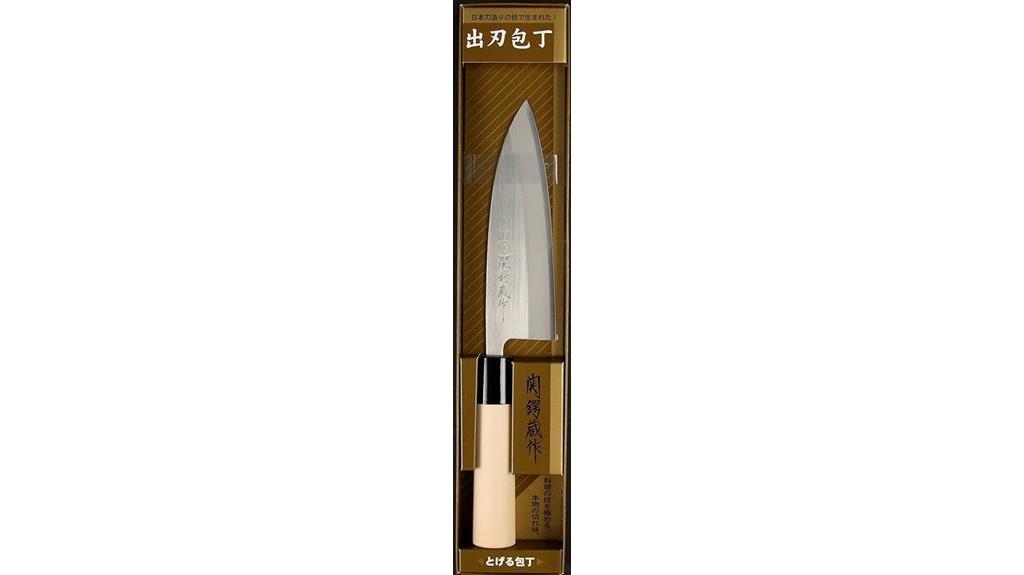
Plunge into the world of precision with the JapanBargain Japanese Deba Knife, a 6-1/4 inch stainless steel marvel crafted for enthusiasts and home chefs who crave razor-sharp performance.
You’ll love its molybdenum rust-resistant blade, perfect for slicing fish, meats, and veggies with ease. Weighing just 7.2 ounces, it offers comfort and control, though its lightness might feel brittle for some.
Keep that edge pristine by hand-washing and drying it, and store it carefully to avoid corrosion. Apply polyurethane to the wooden handle for durability. Remember, it’s not for hard bones—stick to softer cuts for longevity.
Best For: Enthusiasts and home chefs seeking a razor-sharp, lightweight knife for precise cutting of fish, meats, and vegetables.
Pros:
- Razor-sharp molybdenum rust-resistant blade ensures precise cuts.
- Lightweight at 7.2 ounces, offering comfort and control during use.
- Versatile for slicing fish, meats, poultry, and vegetables with ease.
Cons:
- Light weight may feel brittle to some users, lacking heft for heavy tasks.
Kai Wasabi Deba Knife 6, Traditional Japanese Knife for Fish and Poultry

Plunge into the world of precision cutting with the Kai Wasabi Deba Knife 6-inch, a stellar choice for both professional chefs and passionate home cooks.
You’ll appreciate its high-carbon stainless steel blade, perfect for filleting fish and poultry with ease. The single-beveled edge guarantees razor-sharp slices, while the comfortable black polypropylene handle offers a secure grip.
Crafted in Japan’s Seki City, this knife boasts corrosion resistance and excellent edge retention. It’s a fantastic starter tool at an affordable price. Hone it regularly on a whetstone, and you’ve got a reliable companion for developing your knife skills.
Best For: Passionate home cooks and professional chefs looking for an affordable, high-quality Japanese knife to fillet fish and poultry with precision.
Pros:
- Razor-sharp single-beveled blade ensures precise and effortless cuts.
- High-carbon stainless steel offers excellent corrosion resistance and edge retention.
- Comfortable black polypropylene handle provides a secure and ergonomic grip.
Cons:
- Spine edges may be sharp and cause discomfort, though easily remedied by rounding.
- As a stamped knife, it may not match the durability of forged high-end models.
Sakai Takayuki Japanese Deba Knife 165mm
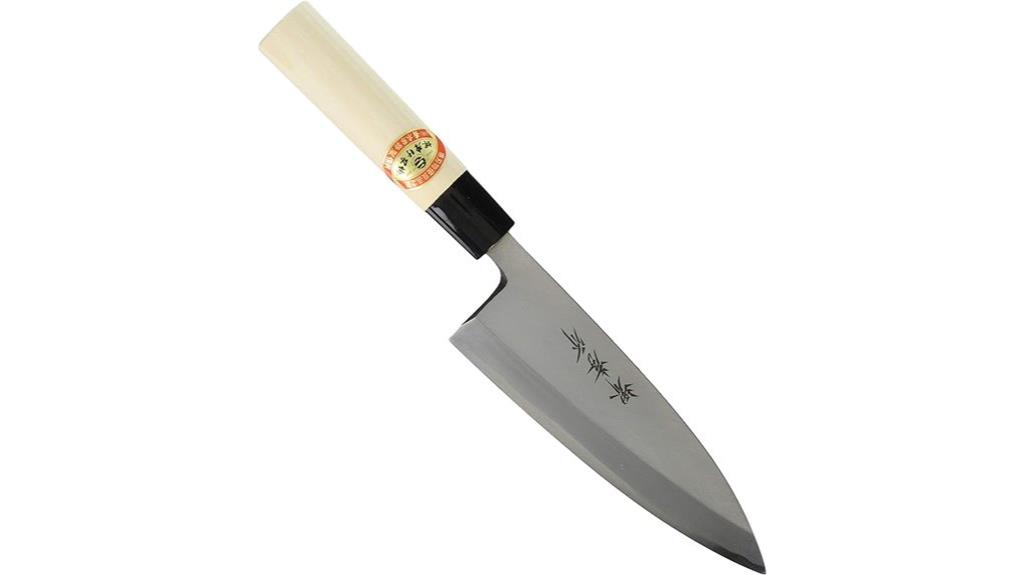
Meet the Sakai Takayuki Japanese Deba Knife 165mm, a standout choice for passionate home cooks and professional chefs who crave precision with tougher cuts of meat.
You’ll appreciate its 165mm blade made of Yasuki white steel, offering sharpness that rivals pricier knives. Weighing 13.8 ounces, it’s user-friendly, giving you better control than standard chef’s knives for thin slicing.
Keep in mind, though, it needs care—wash, dry, and oil it to maintain quality. If quality’s a concern, consider alternatives despite its great value.
Best For: Passionate home cooks and professional chefs seeking precision in slicing tougher cuts of meat with a high-quality Japanese Deba knife.
Pros:
- Exceptional sharpness with a 165mm Yasuki white steel blade, rivaling more expensive knives.
- User-friendly design at 13.8 ounces, offering better control than standard chef’s knives.
- Great value for the price, delivering performance comparable to higher-end options.
Cons:
- Requires diligent care, including washing, drying, and oiling to maintain quality.
kai Seki Magoroku Kinju ST Japanese Deba Knife 180mm (AK-1103)
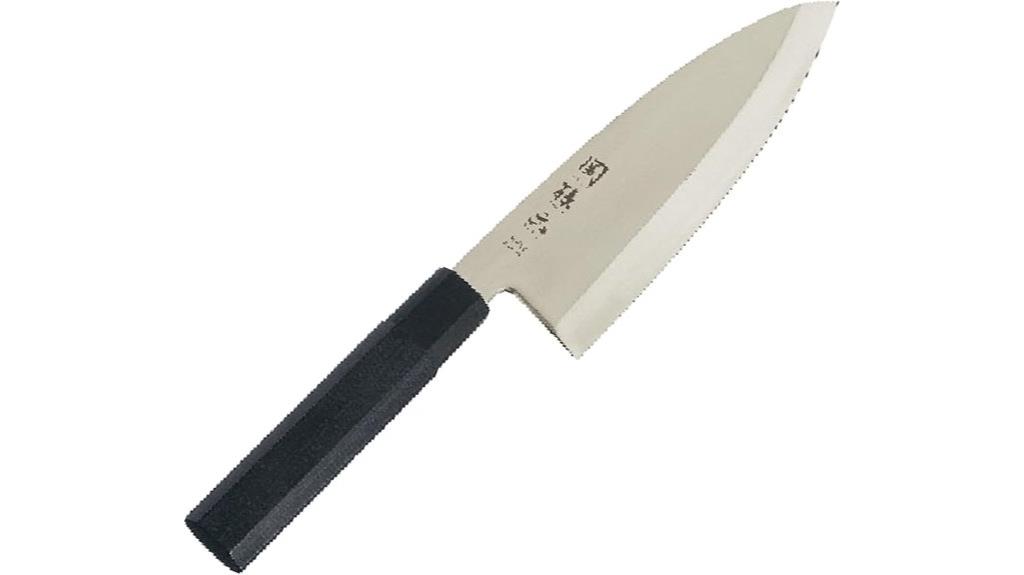
Discover the kai Seki Magoroku Kinju ST Japanese Deba Knife 180mm (AK-1103), a standout choice for seafood enthusiasts and professional chefs who need precision in butchering and filleting fish.
You’ll appreciate its 180mm molybdenum vanadium stainless steel blade, weighing 10.51 ounces, delivering momentum for powerful cuts. The 4mm thick blade and concave back guarantee effective slicing, even for paper-thin prosciutto.
Feel the comfort of the octagonal laminated wood handle as you work. Remember, hand wash only—don’t toss it in the dishwasher. While users rave about its heft, watch for high shipping costs or potential damage during delivery.
Best For: Seafood enthusiasts and professional chefs seeking a specialized tool for precision butchering and filleting fish.
Pros:
- Exceptional heft and 4mm thick blade provide powerful cutting momentum.
- Comfortable octagonal laminated wood handle enhances grip and control.
- High-quality molybdenum vanadium stainless steel ensures durability and sharpness.
Cons:
- Not dishwasher safe, requiring careful hand washing for maintenance.
6 Inch Deba Knife, Japanese High Carbon Steel Kitchen Knife

Experience the precision of the 6 Inch Deba Knife by HOSHANHO, crafted with high carbon steel for exceptional sharpness. You’ll notice its 10Cr15CoMoV steel core and forged layers deliver outstanding cutting power for fish, poultry, and soft vegetables. With a V-shaped edge, it slices with finesse.
Feel the comfort of the ergonomic rosewood and G10 handle, designed for a secure grip without touching the board. Weighing just 250g, it’s lightweight yet balanced for control. Though it’s not dishwasher safe and needs care to avoid chipping, you’ll love its sharpness and ease in food prep.
Best For: Those who are passionate about preparing Japanese cuisine and need a reliable knife for filleting fish and handling poultry with precision.
Pros:
- Exceptional sharpness with a V-shaped edge for precise cutting.
- Ergonomic rosewood and G10 handle ensures a comfortable and secure grip.
- Lightweight at 250g yet well-balanced for optimal control during use.
Cons:
- Needs proper care to prevent chipping and oxidation of the high carbon steel.
imarku 7-inch Deba Knife for Fish Cutting
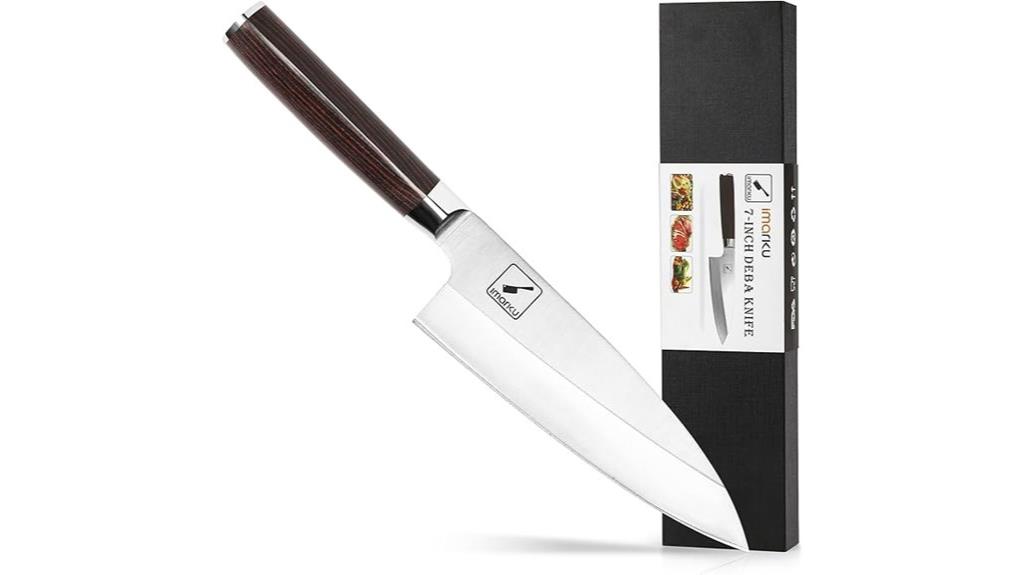
If you’re a Japanese cuisine chef or a seafood cooking enthusiast, the imarku 7-inch Deba Knife is your perfect companion for mastering fish preparation.
This 7-inch blade, made from 5Cr15MoV high carbon stainless steel, offers excellent corrosion resistance and edge retention. It’s ideal for cutting fish heads, breaking bones, and filleting with precision.
You’ll appreciate the single bevel blade, hand-sharpened at 12° to 15°, ensuring clean cuts that preserve flavor. The ergonomic Pakkawood handle provides a secure, non-slip grip for safety.
Best For: Japanese cuisine chefs and seafood cooking enthusiasts seeking a precise and durable knife for fish preparation.
Pros:
- Exceptional sharpness with a hand-sharpened single bevel blade at 12° to 15° for clean, flavor-preserving cuts.
- Durable construction from 5Cr15MoV high carbon stainless steel, offering corrosion resistance and edge retention.
- Ergonomic Pakkawood handle ensures a secure, non-slip grip for safety and comfort during use.
Cons:
- Not dishwasher safe, requiring hand washing to maintain blade quality.
- Heavier weight at 1.15 pounds might cause fatigue during extended use for some individuals.
HEZHEN 7 Deba Knife, Japanese Style Fish Fillet Knife
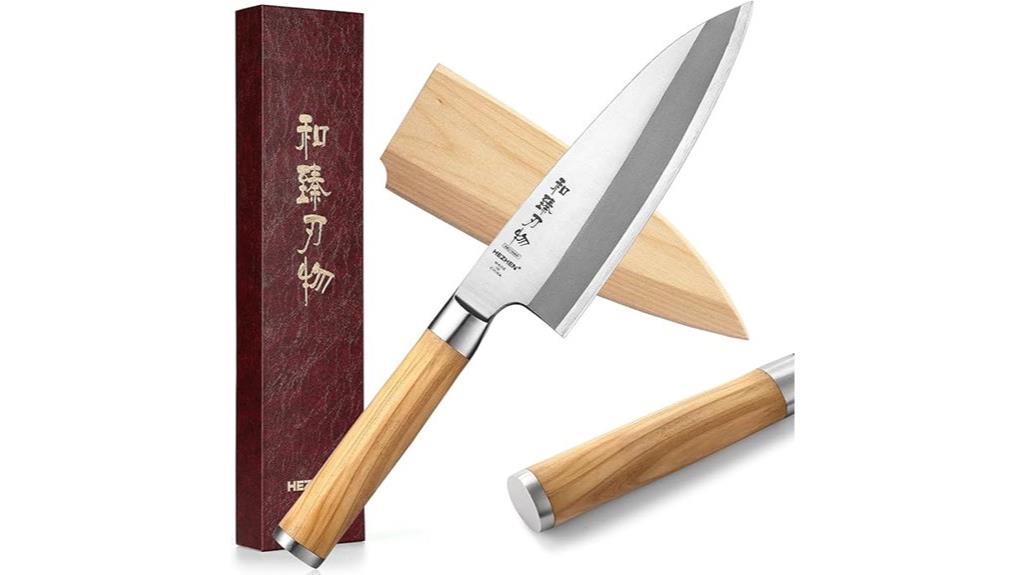
Looking for a reliable tool to handle fish and poultry with precision? Check out the HEZHEN 7 Deba Knife, a Japanese-style fish fillet knife with a 180mm blade made of X8Cr14MoV stainless steel.
Its single-edged design, with a 28° cutting edge, guarantees sharp, clean cuts, while the concave grind reduces food sticking.
You’ll appreciate the ergonomic olive wood handle, crafted for comfort and style, paired with a matching sheath for protection. Though not dishwasher safe, it demands care to prevent rust.
Best For: Chefs and home cooks who need a specialized Japanese-style knife for precise fish and poultry processing.
Pros:
- Sharp, single-edged 28° blade ensures clean and precise cuts.
- Ergonomic olive wood handle offers comfort and a stylish aesthetic.
- Comes with a protective olive wood sheath for safe storage and kitchen decor.
Cons:
- May be less versatile for tasks beyond fish and poultry due to its specialized design.
What Makes a Great Deba Knife? Here’s the Expert Guide
When picking out a Deba knife, you’ve gotta reflect on key aspects like blade material quality and how long the edge retention lasts.
Make sure you’re also checking the handle comfort design, along with the weight and balance that feel right in your hand. Don’t forget to take into account the blade length options to match your specific cutting needs.
Blade Material Quality
Precision matters when selecting a Deba knife, and the blade material quality plays a pivotal role in its performance. You’ll want a material like high carbon stainless steel for its sharpness, durability, and corrosion resistance, striking a balance between performance and ease of care.
Alternatively, consider molybdenum vanadium stainless steel if you’re after a professional-grade option with superior abrasion resistance.
Edge Retention Duration
As you immerse yourself in choosing a Deba knife, edge retention duration stands out as a critical factor for long-term performance.
You’ll want a blade that stays sharp, and high-carbon stainless steel often outperforms standard stainless steel due to its hardness and lasting edge.
Don’t overlook maintenance; regular honing and sharpening every 2-4 weeks, depending on use, can extend edge life. Also, consider your cutting board—opt for softer materials like wood or plastic to avoid dulling the blade quickly.
Handle Comfort Design
How can you guarantee comfort while using a Deba knife for extended periods? It starts with the handle design, a key factor in reducing hand fatigue during tasks like filleting fish or chopping.
Opt for ergonomic handles made from materials like rosewood or polypropylene, as they offer a secure grip and better control. You’ll find maneuvering the knife much easier with these.
Consider handle shapes too—octagonal or contoured designs often fit snugly in your hand, accommodating various grip styles for maximum comfort.
Also, think about the material’s feel; traditional wood adds aesthetic appeal, while synthetic options provide durability and moisture resistance.
Weight and Balance
When selecting a Deba knife, don’t overlook the importance of weight and balance. You’ll find these knives typically weigh between 7 and 13.8 ounces, impacting cutting power and maneuverability.
A heavier knife, around 10 ounces or more, gives you momentum for chopping tough materials, while a lighter one offers precision for delicate tasks.
Make sure the knife feels balanced in your hand, with weight evenly distributed between blade and handle. This balance enhances control and reduces fatigue during long sessions. Whether you’re filleting fish or breaking down poultry, stability matters.
Also, consider construction—forged knives often feel heavier and robust, while stamped ones are lighter and nimbler. Choose what complements your cutting style for ideal performance.
Blade Length Options
Precision matters when picking the right Deba knife, and blade length is a key factor to contemplate. You’ll find Deba knives ranging from 150mm (5.9 inches) to 210mm (8.3 inches), with 6-inch and 7-inch options popular among home cooks and pros.
If you’re working on smaller fish or delicate cuts, go for a 6-inch blade for better control and precision.
For larger fish or thicker bones, opt for a 7-inch or longer blade to gain leverage and power. Keep in mind that longer blades tend to be heavier, demanding a stronger technique.
Maintenance and Care
Since a Deba knife is a valuable investment, you’ll want to prioritize proper maintenance and care to guarantee its longevity. Start by hand washing your knife, as most Deba knives aren’t dishwasher safe. Dry it immediately after washing and apply oil to the blade to prevent rust.
For edge maintenance, use a ceramic honing rod between sharpenings, since Deba knives often need specific techniques for a razor-sharp edge. Store your knife with a blade guard or sheath to protect the edge and avoid accidental damage.
Frequently Asked Questions
How Do I Sharpen a Deba Knife?
Hey, let’s talk about how you can sharpen your knife to keep it in top shape. Grab a whetstone, soak it in water for about 10 minutes, and set it on a stable surface.
Hold the blade at a 10-15 degree angle, then push it across the stone with steady pressure. Repeat on both sides until it’s razor-sharp. Don’t rush—take your time to avoid damaging the edge!
Can a Deba Knife Cut Vegetables?
Ever wielded a blade like a samurai, slicing through challenges with precision? Let’s talk about whether you can use that sharp edge to cut vegetables.
Absolutely, you can! With a Deba knife, you’ll slice through veggies like a hot knife through butter. Just make sure you’ve got a steady hand and a firm grip.
Keep it honed, and you’re ready to chop, dice, and julienne with warrior-like finesse every time!
Is a Deba Knife Dishwasher Safe?
Hey, you’re wondering if a deba knife is dishwasher safe? Well, don’t toss it in there! Most deba knives aren’t designed for dishwashers due to their high-carbon steel blades, which can rust or get damaged by harsh detergents and heat.
You’ve gotta hand-wash it with mild soap and dry it immediately to keep it in top shape. Take care of your knife, and it’ll last you for years!
What Is the History of Deba Knives?
Hey, let’s explore the history of deba knives! You’ll find their origins in Japan, dating back centuries, crafted for filleting fish with precision.
As a traditional tool in Japanese cuisine, they’ve been essential for chefs preparing sushi and sashimi. You can trace their evolution through the Edo period, where craftsmanship peaked.
Today, you’re seeing them cherished worldwide for their sharp, single-beveled edge and cultural significance. Cool, right?
Are Deba Knives Suitable for Left-Handed Users?
Hey, are you wondering if Deba knives work for left-handed users? You’ll be glad to know that they can, but there’s a catch.
Traditional Deba knives are often designed for right-handed folks with a single bevel on one side. Don’t worry, though!
You can find left-handed versions or double-beveled options that suit your needs. Just make certain you’re picking one crafted for your dominant hand to guarantee precision and safety.
Sharpen Your Skills—Your Culinary Quest Begins
Hey, you’ve got the scoop on the 9 best Deba knives to slice through fish like a samurai through battle! Whether you’re wielding the KEEMAKE or the Kai Wasabi, you’re on a quest for precision.
Remember, choosing the right blade is like picking Excalibur—find the one that feels legendary in your hand.
So, grab your Deba, channel your inner kitchen warrior, and conquer that fillet with unmatched skill.

